Junni Zou
3DGabSplat: 3D Gabor Splatting for Frequency-adaptive Radiance Field Rendering
Aug 07, 2025Abstract:Recent prominence in 3D Gaussian Splatting (3DGS) has enabled real-time rendering while maintaining high-fidelity novel view synthesis. However, 3DGS resorts to the Gaussian function that is low-pass by nature and is restricted in representing high-frequency details in 3D scenes. Moreover, it causes redundant primitives with degraded training and rendering efficiency and excessive memory overhead. To overcome these limitations, we propose 3D Gabor Splatting (3DGabSplat) that leverages a novel 3D Gabor-based primitive with multiple directional 3D frequency responses for radiance field representation supervised by multi-view images. The proposed 3D Gabor-based primitive forms a filter bank incorporating multiple 3D Gabor kernels at different frequencies to enhance flexibility and efficiency in capturing fine 3D details. Furthermore, to achieve novel view rendering, an efficient CUDA-based rasterizer is developed to project the multiple directional 3D frequency components characterized by 3D Gabor-based primitives onto the 2D image plane, and a frequency-adaptive mechanism is presented for adaptive joint optimization of primitives. 3DGabSplat is scalable to be a plug-and-play kernel for seamless integration into existing 3DGS paradigms to enhance both efficiency and quality of novel view synthesis. Extensive experiments demonstrate that 3DGabSplat outperforms 3DGS and its variants using alternative primitives, and achieves state-of-the-art rendering quality across both real-world and synthetic scenes. Remarkably, we achieve up to 1.35 dB PSNR gain over 3DGS with simultaneously reduced number of primitives and memory consumption.
Noise Conditional Variational Score Distillation
Jun 11, 2025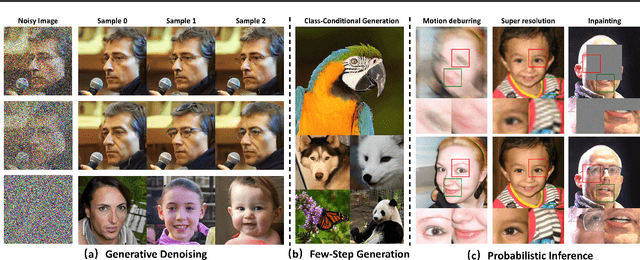
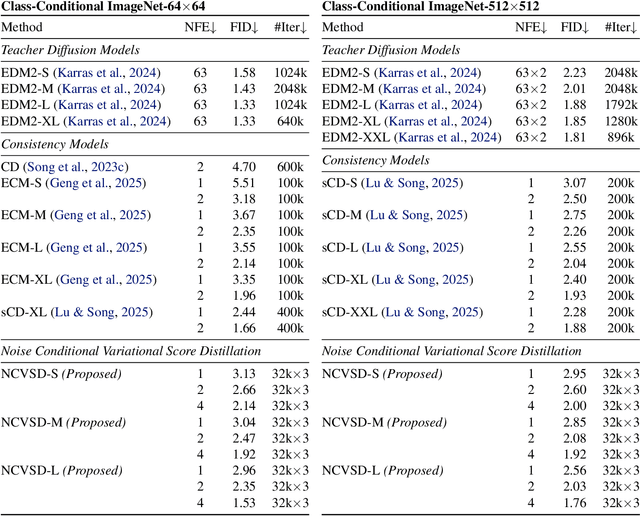

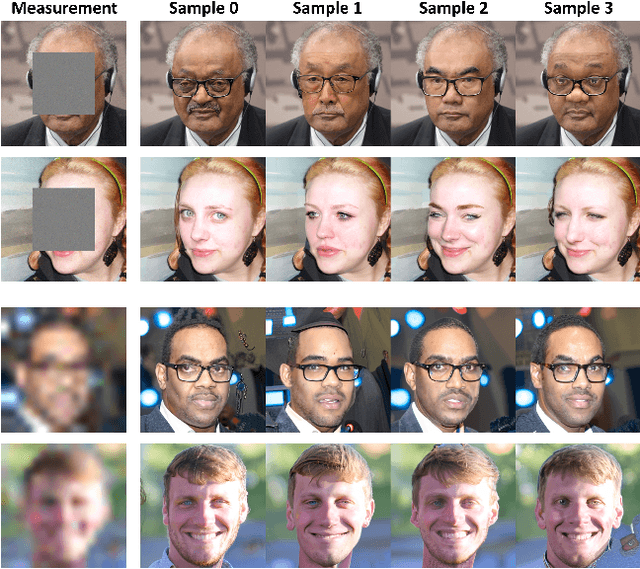
Abstract:We propose Noise Conditional Variational Score Distillation (NCVSD), a novel method for distilling pretrained diffusion models into generative denoisers. We achieve this by revealing that the unconditional score function implicitly characterizes the score function of denoising posterior distributions. By integrating this insight into the Variational Score Distillation (VSD) framework, we enable scalable learning of generative denoisers capable of approximating samples from the denoising posterior distribution across a wide range of noise levels. The proposed generative denoisers exhibit desirable properties that allow fast generation while preserve the benefit of iterative refinement: (1) fast one-step generation through sampling from pure Gaussian noise at high noise levels; (2) improved sample quality by scaling the test-time compute with multi-step sampling; and (3) zero-shot probabilistic inference for flexible and controllable sampling. We evaluate NCVSD through extensive experiments, including class-conditional image generation and inverse problem solving. By scaling the test-time compute, our method outperforms teacher diffusion models and is on par with consistency models of larger sizes. Additionally, with significantly fewer NFEs than diffusion-based methods, we achieve record-breaking LPIPS on inverse problems.
HiPART: Hierarchical Pose AutoRegressive Transformer for Occluded 3D Human Pose Estimation
Mar 30, 2025Abstract:Existing 2D-to-3D human pose estimation (HPE) methods struggle with the occlusion issue by enriching information like temporal and visual cues in the lifting stage. In this paper, we argue that these methods ignore the limitation of the sparse skeleton 2D input representation, which fundamentally restricts the 2D-to-3D lifting and worsens the occlusion issue. To address these, we propose a novel two-stage generative densification method, named Hierarchical Pose AutoRegressive Transformer (HiPART), to generate hierarchical 2D dense poses from the original sparse 2D pose. Specifically, we first develop a multi-scale skeleton tokenization module to quantize the highly dense 2D pose into hierarchical tokens and propose a Skeleton-aware Alignment to strengthen token connections. We then develop a Hierarchical AutoRegressive Modeling scheme for hierarchical 2D pose generation. With generated hierarchical poses as inputs for 2D-to-3D lifting, the proposed method shows strong robustness in occluded scenarios and achieves state-of-the-art performance on the single-frame-based 3D HPE. Moreover, it outperforms numerous multi-frame methods while reducing parameter and computational complexity and can also complement them to further enhance performance and robustness.
On Disentangled Training for Nonlinear Transform in Learned Image Compression
Jan 23, 2025Abstract:Learned image compression (LIC) has demonstrated superior rate-distortion (R-D) performance compared to traditional codecs, but is challenged by training inefficiency that could incur more than two weeks to train a state-of-the-art model from scratch. Existing LIC methods overlook the slow convergence caused by compacting energy in learning nonlinear transforms. In this paper, we first reveal that such energy compaction consists of two components, i.e., feature decorrelation and uneven energy modulation. On such basis, we propose a linear auxiliary transform (AuxT) to disentangle energy compaction in training nonlinear transforms. The proposed AuxT obtains coarse approximation to achieve efficient energy compaction such that distribution fitting with the nonlinear transforms can be simplified to fine details. We then develop wavelet-based linear shortcuts (WLSs) for AuxT that leverages wavelet-based downsampling and orthogonal linear projection for feature decorrelation and subband-aware scaling for uneven energy modulation. AuxT is lightweight and plug-and-play to be integrated into diverse LIC models to address the slow convergence issue. Experimental results demonstrate that the proposed approach can accelerate training of LIC models by 2 times and simultaneously achieves an average 1\% BD-rate reduction. To our best knowledge, this is one of the first successful attempt that can significantly improve the convergence of LIC with comparable or superior rate-distortion performance. Code will be released at \url{https://github.com/qingshi9974/AuxT}
Point Cloud Resampling with Learnable Heat Diffusion
Nov 21, 2024Abstract:Generative diffusion models have shown empirical successes in point cloud resampling, generating a denser and more uniform distribution of points from sparse or noisy 3D point clouds by progressively refining noise into structure. However, existing diffusion models employ manually predefined schemes, which often fail to recover the underlying point cloud structure due to the rigid and disruptive nature of the geometric degradation. To address this issue, we propose a novel learnable heat diffusion framework for point cloud resampling, which directly parameterizes the marginal distribution for the forward process by learning the adaptive heat diffusion schedules and local filtering scales of the time-varying heat kernel, and consequently, generates an adaptive conditional prior for the reverse process. Unlike previous diffusion models with a fixed prior, the adaptive conditional prior selectively preserves geometric features of the point cloud by minimizing a refined variational lower bound, guiding the points to evolve towards the underlying surface during the reverse process. Extensive experimental results demonstrate that the proposed point cloud resampling achieves state-of-the-art performance in representative reconstruction tasks including point cloud denoising and upsampling.
Point Cloud Denoising With Fine-Granularity Dynamic Graph Convolutional Networks
Nov 21, 2024Abstract:Due to limitations in acquisition equipment, noise perturbations often corrupt 3-D point clouds, hindering down-stream tasks such as surface reconstruction, rendering, and further processing. Existing 3-D point cloud denoising methods typically fail to reliably fit the underlying continuous surface, resulting in a degradation of reconstruction performance. This paper introduces fine-granularity dynamic graph convolutional networks called GD-GCN, a novel approach to denoising in 3-D point clouds. The GD-GCN employs micro-step temporal graph convolution (MST-GConv) to perform feature learning in a gradual manner. Compared with the conventional GCN, which commonly uses discrete integer-step graph convolution, this modification introduces a more adaptable and nuanced approach to feature learning within graph convolution networks. It more accurately depicts the process of fitting the point cloud with noise to the underlying surface by and the learning process for MST-GConv acts like a changing system and is managed through a type of neural network known as neural Partial Differential Equations (PDEs). This means it can adapt and improve over time. GD-GCN approximates the Riemannian metric, calculating distances between points along a low-dimensional manifold. This capability allows it to understand the local geometric structure and effectively capture diverse relationships between points from different geometric regions through geometric graph construction based on Riemannian distances. Additionally, GD-GCN incorporates robust graph spectral filters based on the Bernstein polynomial approximation, which modulate eigenvalues for complex and arbitrary spectral responses, providing theoretical guarantees for BIBO stability. Symmetric channel mixing matrices further enhance filter flexibility by enabling channel-level scaling and shifting in the spectral domain.
Image Compression for Machine and Human Vision with Spatial-Frequency Adaptation
Jul 13, 2024Abstract:Image compression for machine and human vision (ICMH) has gained increasing attention in recent years. Existing ICMH methods are limited by high training and storage overheads due to heavy design of task-specific networks. To address this issue, in this paper, we develop a novel lightweight adapter-based tuning framework for ICMH, named Adapt-ICMH, that better balances task performance and bitrates with reduced overheads. We propose a spatial-frequency modulation adapter (SFMA) that simultaneously eliminates non-semantic redundancy with a spatial modulation adapter, and enhances task-relevant frequency components and suppresses task-irrelevant frequency components with a frequency modulation adapter. The proposed adapter is plug-and-play and compatible with almost all existing learned image compression models without compromising the performance of pre-trained models. Experiments demonstrate that Adapt-ICMH consistently outperforms existing ICMH frameworks on various machine vision tasks with fewer fine-tuned parameters and reduced computational complexity. Code will be released at https://github.com/qingshi9974/ECCV2024-AdpatICMH .
Improving Diffusion Models for Inverse Problems Using Optimal Posterior Covariance
Feb 03, 2024



Abstract:Recent diffusion models provide a promising zero-shot solution to noisy linear inverse problems without retraining for specific inverse problems. In this paper, we propose the first unified interpretation for existing zero-shot methods from the perspective of approximating the conditional posterior mean for the reverse diffusion process of conditional sampling. We reveal that recent methods are equivalent to making isotropic Gaussian approximations to intractable posterior distributions over clean images given diffused noisy images, with the only difference in the handcrafted design of isotropic posterior covariances. Inspired by this finding, we propose a general plug-and-play posterior covariance optimization based on maximum likelihood estimation to improve recent methods. To achieve optimal posterior covariance without retraining, we provide general solutions based on two approaches specifically designed to leverage pre-trained models with and without reverse covariances. Experimental results demonstrate that the proposed methods significantly enhance the overall performance or robustness to hyperparameters of recent methods. Code is available at https://github.com/xypeng9903/k-diffusion-inverse-problems
UMG-CLIP: A Unified Multi-Granularity Vision Generalist for Open-World Understanding
Jan 18, 2024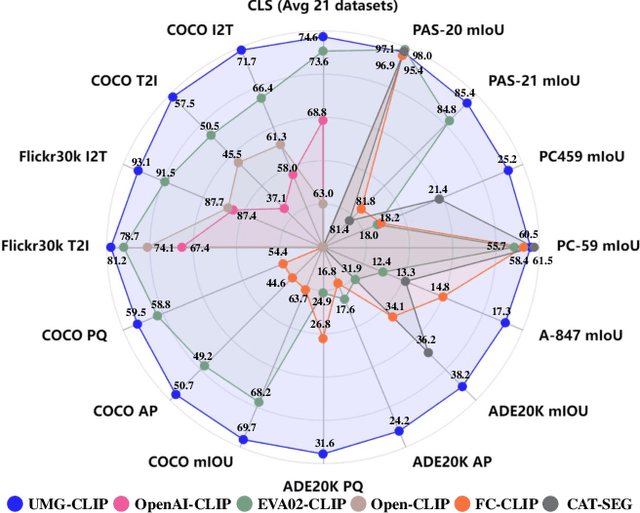
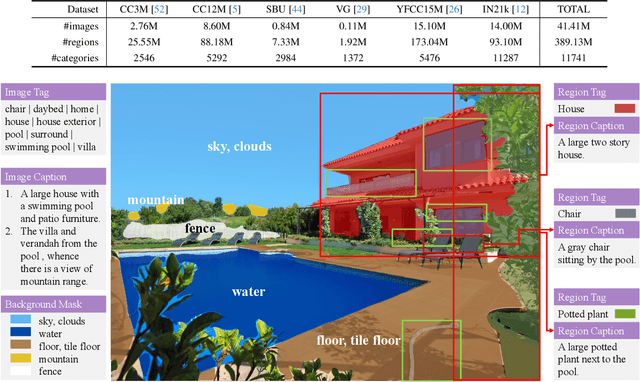
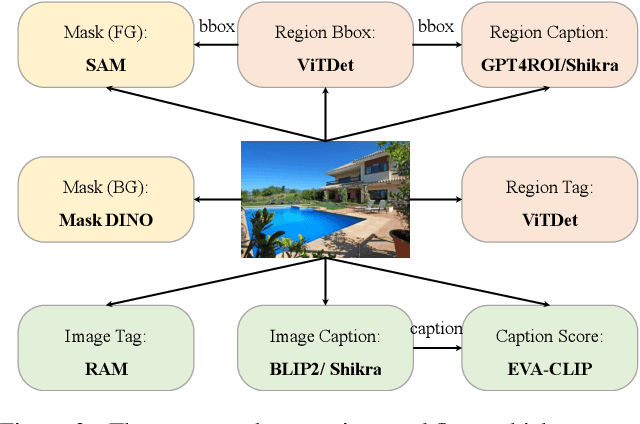
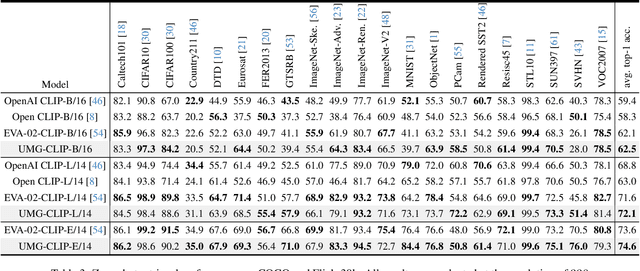
Abstract:Vision-language foundation models, represented by Contrastive language-image pre-training (CLIP), have gained increasing attention for jointly understanding both vision and textual tasks. However, existing approaches primarily focus on training models to match global image representations with textual descriptions, thereby overlooking the critical alignment between local regions and corresponding text tokens. This paper extends CLIP with multi-granularity alignment. Notably, we deliberately construct a new dataset comprising pseudo annotations at various levels of granularities, encompassing image-level, region-level, and pixel-level captions/tags. Accordingly, we develop a unified multi-granularity learning framework, named UMG-CLIP, that simultaneously empowers the model with versatile perception abilities across different levels of detail. Equipped with parameter efficient tuning, UMG-CLIP surpasses current widely used CLIP models and achieves state-of-the-art performance on diverse image understanding benchmarks, including open-world recognition, retrieval, semantic segmentation, and panoptic segmentation tasks. We hope UMG-CLIP can serve as a valuable option for advancing vision-language foundation models.
scBiGNN: Bilevel Graph Representation Learning for Cell Type Classification from Single-cell RNA Sequencing Data
Dec 16, 2023Abstract:Single-cell RNA sequencing (scRNA-seq) technology provides high-throughput gene expression data to study the cellular heterogeneity and dynamics of complex organisms. Graph neural networks (GNNs) have been widely used for automatic cell type classification, which is a fundamental problem to solve in scRNA-seq analysis. However, existing methods do not sufficiently exploit both gene-gene and cell-cell relationships, and thus the true potential of GNNs is not realized. In this work, we propose a bilevel graph representation learning method, named scBiGNN, to simultaneously mine the relationships at both gene and cell levels for more accurate single-cell classification. Specifically, scBiGNN comprises two GNN modules to identify cell types. A gene-level GNN is established to adaptively learn gene-gene interactions and cell representations via the self-attention mechanism, and a cell-level GNN builds on the cell-cell graph that is constructed from the cell representations generated by the gene-level GNN. To tackle the scalability issue for processing a large number of cells, scBiGNN adopts an Expectation Maximization (EM) framework in which the two modules are alternately trained via the E-step and M-step to learn from each other. Through this interaction, the gene- and cell-level structural information is integrated to gradually enhance the classification performance of both GNN modules. Experiments on benchmark datasets demonstrate that our scBiGNN outperforms a variety of existing methods for cell type classification from scRNA-seq data.
 Add to Chrome
Add to Chrome Add to Firefox
Add to Firefox Add to Edge
Add to Edge